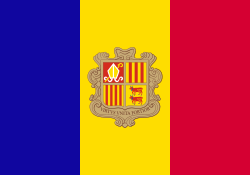 | |
| Use | State flag |
|---|---|
| Proportion | 7:10 |
| Adopted | 1866 (Tricolor) 1993 (official coat of arms) |
| Design | A vertical tricolour of blue, yellow and red with the National Coat of Arms centred on the yellow band. |
| Designed by | Napoleon III (traditionally attributed) |
 | |
| Use | Civil flag and ensign |
| Proportion | 7:10 |
| Adopted | 1866 |
| Design | A vertical tricolour of blue, yellow and red. |
| Designed by | Napoleon III |

The national flag of Andorra (Bandera d'Andorra) features a vertical tricolour of blue, yellow, and red with the coat of arms of Andorra in the center. The centre yellow bar is slightly wider than the other two so that the ratio of bar widths is 8:9:8 with an overall flag ratio of 7:10.
Contents
- Origins and symbolism
- Description
- Colors
- Construction sheet
- History
- First flag
- Second flag
- Later flags
- Other flags of Andorra
- Municipal flags
- Other
- See also
- References
- External links
The civilian variant of the flag without a coat of arms was created in 1866. Although throughout the 19th and 20th century there were variant designs based on this, carrying a variety of arms and occasionally switching from vertical to horizontal stripes, the design was standardized in 1993 after Andorra joined the United Nations.
























